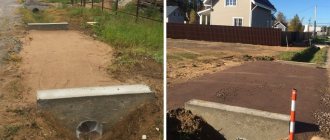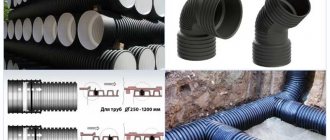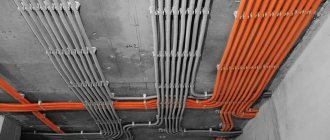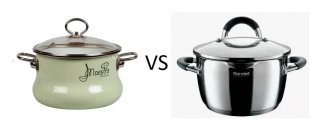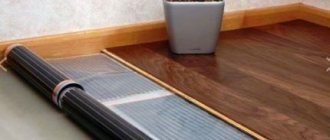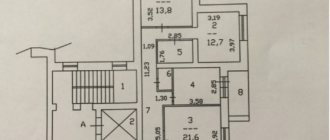Underground cable laying is becoming increasingly popular, including when it comes to communications for private homes. This method allows you to protect wires from breaks caused by strong gusts of wind, snow falling from roofs, and branches of trees growing on the site. But it also has its drawbacks associated with soil pressure, exposure to groundwater and other harmful factors. However, a special pipe for laying cables in the ground almost completely eliminates them, taking on all the harmful load.
Aerial cable laying increases the risk of cable breakage Source repair-pavlovsky-posad.rf
Justifications for underground installation of wire communications
Initially, underground cable installation requires higher costs than overhead installation. But in the end, the operation of such communications requires virtually no costs. They are not affected by such natural factors as strong winds, snowfalls, icing, they are more difficult to damage mechanically, they are protected from vandalism and theft.
In the event of damage, restoring and repairing overhead lines requires a lot of money and time, and a long absence of electricity and communications in the house causes related problems and inconveniences.
The section from the main pole to the house is always the most dangerous, as it is often broken off by snow falling from the roof and damaged by branches of fruit trees growing on the site. This is what they most often try to lay underground. Using the same method, it is best to pull the cable from the house to the bathhouse, garage and other outbuildings, so as not to install extra poles on the site.
Scheme of laying a cable in a trench from a pole to a house Source dom-expert.by
In addition to electrical cables, a modern house comes with many cables - telephone, control, computer, television. In order not to entangle it with wires, they can all be brought inside, combined into one bundle, and a pipe or corrugation for laying the cable in the ground will protect it from stray currents, groundwater, rodents and various damages.
Which manufacturers are trustworthy?
Do not buy openly “no-name” corrugation, as practice has shown that the stated characteristics often do not correspond to reality. Of the manufacturers that deserve trust, we note the following:
- DKC;
- I.E.K.;
- EKF;
- KOPOS;
- ERA;
- Ekoplast;
- RUVINYL;
- NASHORN - so far only PVC corrugation is in stock.
Their components are of course more expensive than their Chinese counterparts, but the quality is many times better. Moreover, there are no problems buying in Russia.
Some more interesting things from the world of electrical engineering:
- Why is there 220 V between phase and zero, and 380 V between phases?
- Why is the voltage in the US 110 V, and in Russia 220 V?
Types of pipes used
In previous years, underground installation was carried out using steel and asbestos cement pipes. Now they have added products made from different types of plastic:
- polyvinyl chloride;
- polypropylene;
- high pressure polyethylene;
- low density polyethylene.
The use of each type is regulated by regulatory documents - GOST and SNiP. For example, only a control cable is allowed to be laid underground in a steel casing, since the power cable with such installation has no protection in the event of a breakdown.
Steel pipes today are used for wiring inside buildings Source wirings-diagram.com
Asbestos-cement pipes are almost never used these days due to their fragility and heavy weight; the use of steel pipes, which are quite expensive and subject to corrosion in a humid environment, is also limited. They were replaced by plastic, the material is lightweight, durable, non-corrosive, and has excellent dielectric properties. Plastic pipes can have different cross-sections, wall thicknesses, be smooth or corrugated, single- or double-layer.
Safety requirements
By laying the cable in a metal pipe, it is possible to ensure fire safety and protect the cable itself. But one more problem remains - electrical safety. The metal conducts current; when a bare wire comes into contact with the pipe wall, there is a danger of a person receiving an electric shock, heating up the protective casing, and igniting nearby objects.
It is not enough to simply hide the electrical cable - so that the electrical network does not cause a tragedy, certain requirements must be observed:
- Cables with a triple braid are laid in a metal pipe - even if one layer of braid is damaged during pulling, there will be no contact between the wire and the metal.
- If the voltage in the cable is above 42 V, the casing must be grounded. This will protect against electric shock when touching a pipe that has come into contact with an electrical wire.
- Moisture must not get inside the pipe, as this will lead to corrosion of the casing and destruction of the wire braid. Therefore, the pipe system must be sealed and connections must be reliable.
- If the casing material is susceptible to corrosion, it should be coated with metal paint - this will extend the service life and prevent depressurization of the system.
- The distance from the pipe with the cable to the heating pipe must be at least 20 cm. Near sources of high temperature or open fire, the casing of the electrical cable must be covered with a heat shield - a curved steel plate that will reflect part of the heat.
Products made from low-density polyethylene
The most obvious popularity is the HDPE pipe for laying cables in the ground; it is divided into two main types:
- technical – general purpose;
- electrical – designed specifically for the installation of underground cable ducts.
Technical
Power transmission lines and other utility networks can be laid in different pipes. Technical pipes that have smooth single-layer walls and are painted black are also quite suitable for these purposes. They have all the necessary characteristics: resistance to aggressive chemicals, mechanical strength, electrical insulating properties.
Technical single-layer pipes Source yahplastic.com.pk
Since such products have a universal purpose, they are not equipped with devices for tightening the cable.
Smooth single-wall polyethylene pipes are rigid and flexible. Laying HDPE pipes in the ground is permitted only in a rigid version, as is pouring the cable into a concrete floor screed or laying it in brickwork. Flexible tubes are used to protect electrical wiring inside the house.
See also: Catalog of companies that specialize in electrical work of any complexity
Electrical
Double-wall pipes are more suitable for underground networks. They can accommodate power lines with AC or DC voltages up to 1000 V.
Double-wall pipes are produced smooth and corrugated, their outer shell is made of HDPE, and the smooth inner shell is made of another type of PE - high-density polyethylene. The most durable and reliable products are those with corrugated outer walls, which are reinforced with thin steel wire.
Double-wall corrugated pipes Source twimg.com
Laying a cable in the ground in a HDPE pipe of this type is characterized by maximum simplicity and speed of installation due to smooth internal walls that do not create obstacles for its pulling. And the outer corrugated shell has excellent ring rigidity and does not wrinkle or break under the weight of a thick layer of soil. At the same time, corrugated pipes have a low dead weight, which also facilitates transportation, placement in trenches and assembly.
The features of the material, which retains strength and elasticity at any temperature, resistance to chemically aggressive environments and ultraviolet sunlight, do not create problems during storage and allow installation both in the summer heat and in the winter cold.
Advantages and disadvantages of open wiring
Wood is a flammable material, despite all the impregnations with fire retardants. For this reason, hidden wiring carries a certain risk. When the cables are hidden deep in the wall, any short circuit can cause a fire . In such cases, it is difficult to immediately determine the source of the fire and the cause of the fire.
Easier access to exposed wiring in a wooden house allows for timely detection and repair of damage. This makes it much easier to prevent a fire. At the same time, it is convenient to add additional links - sockets, switches. The disadvantage of open wiring is that the cables are located in visible places. However, this can be compensated for by choosing the right method of camouflage for them .
Video description
Confirmation of how durable a corrugated pipe is is this video:
Installation features
The electrical HDPE pipe for cables in the ground has design features that distinguish it from general purpose pipes.
- For a quick, reliable and tight connection, they are equipped with special couplings without sockets.
- To pull the cable through the pipe, the products are equipped with special probes in the form of steel wire.
Couplings for joining pipe sections Source elnow.ru
Selection of pipes according to technical characteristics
The greater the depth to which the cable corrugation is laid in the ground, the greater the mechanical strength it should have. Strength depends not only on the thickness of the walls, but on their ratio to the diameter of the pipe. It is determined by dividing the outer diameter by the wall thickness and is indicated by the SDR indicator: the lower it is, the higher the reliability of the product.
Table for determining SDR Source moikolodets.ru
Important nuances of grounding
Protective grounding performs a safety function in the event of human contact with electric current.
Its impact is manifested as follows:
- at 0.6-1.5 thousand µA the effect of electricity on the human body is felt;
- at 2-4 thousand μA, fingers tremble;
- at 5-7 thousand μA, the hands cramp;
- at 10-15 thousand µA without outside help it is almost impossible to release the hand with the conductor;
- at 20-25 thousand μA, severe pain appears, breathing is difficult, and it is impossible to take your hands off the wire;
- at 50-80 thousand μA, paralysis of the respiratory system occurs, and disruptions in the functioning of the heart are observed.
Advantages of polyethylene pipes over steel pipes
A much lower price is an important, but not the most important advantage of plastic products compared to metal ones. A polyethylene pipe for underground cables has other advantages.
- Long service life.
For reference! The minimum warranty period specified by manufacturers is 50 years. But with high-quality installation and operation under normal conditions, it can turn out to be much more.
- Easy installation, the ability to connect small cross-section pipes without welding.
- Possibility of laying routes with bends without unnecessary fittings.
Laying along a curved path Source elektroas.ru
- Light weight.
- Strength at any temperature.
- Resistant to corrosion and rotting due to moisture.
- Excellent electrical insulating properties, allowing you to do without grounding.
- Safety against short circuits - the plastic shell stops combustion.
- Environmental safety - polyethylene does not decompose in the ground and does not emit toxic substances.
Is it possible to put wiring in a metal-plastic pipe under a wooden ceiling? Or is it just corrugation?
It's all about fire safety. If you install corrugation inside the ceiling, you personally block access to the possibility of extinguishing it. Therefore, according to all SNIPs, it is possible to lay the wire only in met. pipe Although abroad, indeed, this issue is simplified to the simplest option, by installing an RCD (differential automatic device..). We also have a simple option, this is a cable channel, which is installed from the outside and complies with all standards, but it is not always possible to install it, for example: a suspended ceiling..
There is another option: cover the wire with plaster mixture 2 cm around, this is also allowed.. You are asking about a metal-plastic pipe. If you are using the wiring you are installing only for lighting, then the thickness of the metal should be sufficient for safe operation of this wiring.
But this pipe is not certified and, as you understand, you are responsible for this. He can simply purchase a piece of the necessary meth from the store. pipes and don’t invent anything and sleep peacefully... You don’t need much and it’s not very expensive..
Briefly about the main thing
When thinking about electrifying a country house and outbuildings, it is worth considering the option of underground cable laying, as the most reliable, safe and durable. To ensure that communications are not exposed to the harmful effects of moisture, do not experience soil pressure, and are not accidentally damaged when digging the site, they are placed in a durable casing made of pipes. Today, HDPE pipes are considered the best, having excellent technical characteristics corresponding to operating conditions. The most critical lines are best laid in double-wall corrugated pipes.
Laying cables under the road
The laying of cables under the road in pipes is carried out with the permission of the organization on whose balance sheet the road is located. This point is especially relevant for routes located in populated areas, since other communications may pass under them. If laying under the road is carried out in a holiday village, then such an event must be agreed upon with the administration.
The rules for installing a power line in a protective casing under an unpaved road surface are the same as for conventional installation. The depth, arrangement of the sand cushion, backfill and other parameters coincide with the usual installation of communications. The electrical cable is laid in a pipe under a paved road, usually using the puncture method. Puncture involves the use of special equipment and is a trenchless method of arranging communications, however, the cost of such work is quite high.
